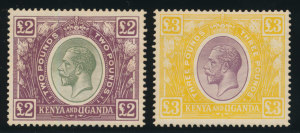When collectors rail about excess new issue stamps soaking up their collecting budget and leaving them with little to spend on older stamps, they are only part of a long tradition of collectors who have bought stamps for their collections that were issued for reasons other than postal need. Some of the most popular stamps in all of philately, the George V and George VI high values, fit this description. When they were first issued, the enormous face values of some of the stamps (even up to as much as 100 Pounds postage value, a sum equal to the average annual wage for a construction worker in 1920-1930, the years such stamps were being issued) cause dolorous denunciations in the philatelic press.


British Colony High Values
The high pound value stamps were only issued for a few African and Asian colonies, and there was a shred of legitimacy to them. The countries, which included Kenya, Uganda, and Tanganyika and Ceylon, were places where quantities of valuable smaller items such as diamonds and gold could be posted, and, it was surmised, that stamps might be needed to pay for packages sent from these areas. Really, though, the stamps were doing double duty, so to speak. The stamps were inscribed “Postage and Revenue,” and it is many times more likely to see used stamps that were used to pay fiscal duties than for use as postage stamps. The Scott catalog usually prices these stamps both postally used and with fiscal cancels (fiscal use is usually indicated by a pen or manuscript cancel, or by a colored cancel

